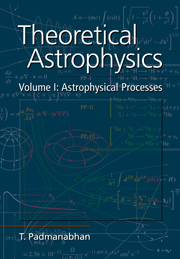Book contents
- Frontmatter
- Contents
- Preface
- Chapter 1 Order-of-Magnitude Astrophysics
- Chapter 2 Dynamics
- Chapter 3 Special Relativity, Electrodynamics, and Optics
- Chapter 4 Basics of Electromagnetic Radiation
- Chapter 5 Statistical Mechanics
- Chapter 6 Radiative Processes
- Chapter 7 Spectra
- Chapter 8 Neutral Fluids
- Chapter 9 Plasma Physics
- Chapter 10 Gravitational Dynamics
- Chapter 11 General Theory of Relativity
- Chapter 12 Basics of Nuclear Physics
- Notes and References
- Index
Chapter 8 - Neutral Fluids
Published online by Cambridge University Press: 05 June 2012
- Frontmatter
- Contents
- Preface
- Chapter 1 Order-of-Magnitude Astrophysics
- Chapter 2 Dynamics
- Chapter 3 Special Relativity, Electrodynamics, and Optics
- Chapter 4 Basics of Electromagnetic Radiation
- Chapter 5 Statistical Mechanics
- Chapter 6 Radiative Processes
- Chapter 7 Spectra
- Chapter 8 Neutral Fluids
- Chapter 9 Plasma Physics
- Chapter 10 Gravitational Dynamics
- Chapter 11 General Theory of Relativity
- Chapter 12 Basics of Nuclear Physics
- Notes and References
- Index
Summary
Introduction
We use the concepts developed in some of the previous chapters (especially Chap. 5) to study the physical processes in fluids in this chapter. The emphasis is on aspects of fluid mechanics that are of relevance in astrophysics. This chapter will be needed in Chaps. 9 and 10 and in several sections of Vols. II and III.
Molecular Collisions and Evolution of the Distribution Function
At the microscopic level, a fluid can be thought of as a collection of molecules. Ignoring the internal structure of the molecules, we can specify the state of any molecule by giving its position x and momentum p. Let dN = f(x, p, t) d3xd3p denote the number of molecules in a phase volume d3xd3p at time t. We are interested in the form and evolution of this distribution function.
The distribution function changes because of two kinds of physical processes. Macroscopic force fields, such as the gravitational field, can exert forces on the molecules and influence their motion. Such a force, Fsm(x, t) ≡ -ΔUsm (x, t), will vary smoothly over the microscopic scales and can be derived from a suitable potential Usm. A particular molecule will also experience the force Fcoll that is due to collision with another molecule whenever it is close to another molecule. At a fundamental level, collisions arise because of two molecules interacting by means of the intermolecular force.
- Type
- Chapter
- Information
- Theoretical Astrophysics , pp. 361 - 427Publisher: Cambridge University PressPrint publication year: 2000



